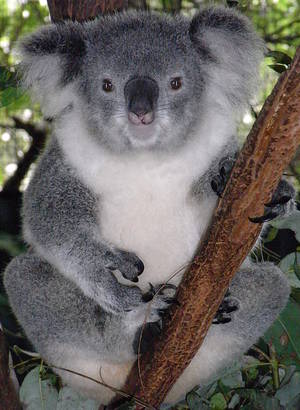Why are Koalas tree-huggers?
Interview with
Alongside the kangaroo, koalas are one of Australia's iconic animals.
People call them koala bears, but they're not really bears, they're actually marsupials and they live in - and exclusively eat the leaves of - eucalyptus trees.
They also hug the trunks of their host trees very tightly. But not just to help them hang on. Using infrared cameras, scientists at the University of Melbourne have found that they do it to keep cool, as Victoria Gill explained to Chris Smith.
Victoria - This is about koalas controlling their body temperature. I mean, you might remember some of the new stories about the extreme heat wave that they had in Australia, particularly in Queensland and South Australia last year or earlier this year in our winter, in the northern hemisphere. This is about them hugging trees to actually cool down their bodies. So, these researchers were studying koalas out in a sanctuary and they were observing their behaviour to see how they regulate their body temperature because in these extreme environments, that's very important for their survival. They noticed that in the summers, on very, very hot days, they would come further down into the trees and press themselves right up against the really thick parts of the trees. This is a bit puzzling because the researchers assumed that they would sort of open up their bodies to lose heat, but they're actually hugging the trees even tighter. When this team from the University of Melbourne got their hands on a thermal imaging camera, they saw exactly what the koalas were doing. The tree trunks are much cooler than the air temperature, as much as 7 degrees cooler than the air temperature. The koalas are actually pressing their bodies, wedging their bodies right up against the coolest parts of the tree in order to lose heat.
Chris - That's a big difference in temperature, isn't it?
Victoria - It is indeed. That's what's important about this study in terms of what it shows about this particular environment. Big trees and it has to be big trees because they have these very dense trunks that can retain that temperature difference, that coolness, are very, very important little microclimates for these tree-dwelling animals. And they allow them very importantly to lose heat without panting. That's crucial for these animals because they have very little access to water if they're up high in the trees feeding. They can often not get access to water very easily and if they pant, they actually evaporate water out of their bodies and lose this water. But if they just press their bodies very closely against the tree, they can lose heat without losing that precious water.
Chris - So, there's a couple of issues here isn't there? The scale of the trees - big trees - they're in demand for logging and timber. And they're hard to replace. And then there's the issue of climate change which is also going to having implications for the temperature and the sorts of plants that will grow so the animals could face a double whammy.
Victoria - Absolutely. I mean, it's a troubling picture for koalas anyway at the moment. But at least, it gives researchers an insight and it gives ecologists and people who make decisions about what areas of landscape to protect specifically for nature reserves and for these animals, it gives them an insight into just how important big trees are. And shows that they are actually - they're microclimates in themselves which are going to be crucial in the future as temperatures increase globally. So, it just shows that these big trees are what need protecting for these tree-dwelling animals.
- Previous Can bad moods be contagious?
- Next Gene of the Month - Delila










Comments
Add a comment